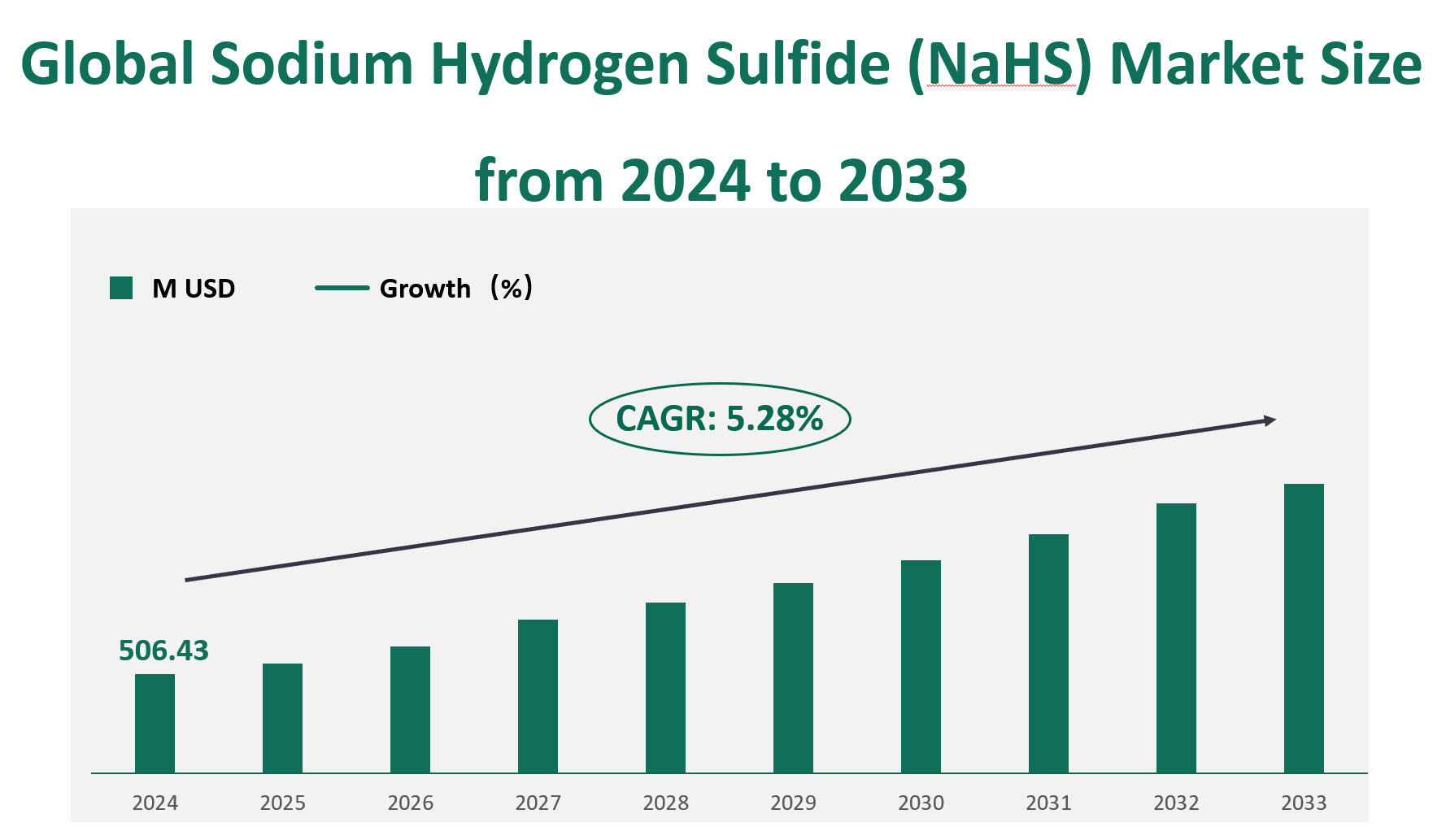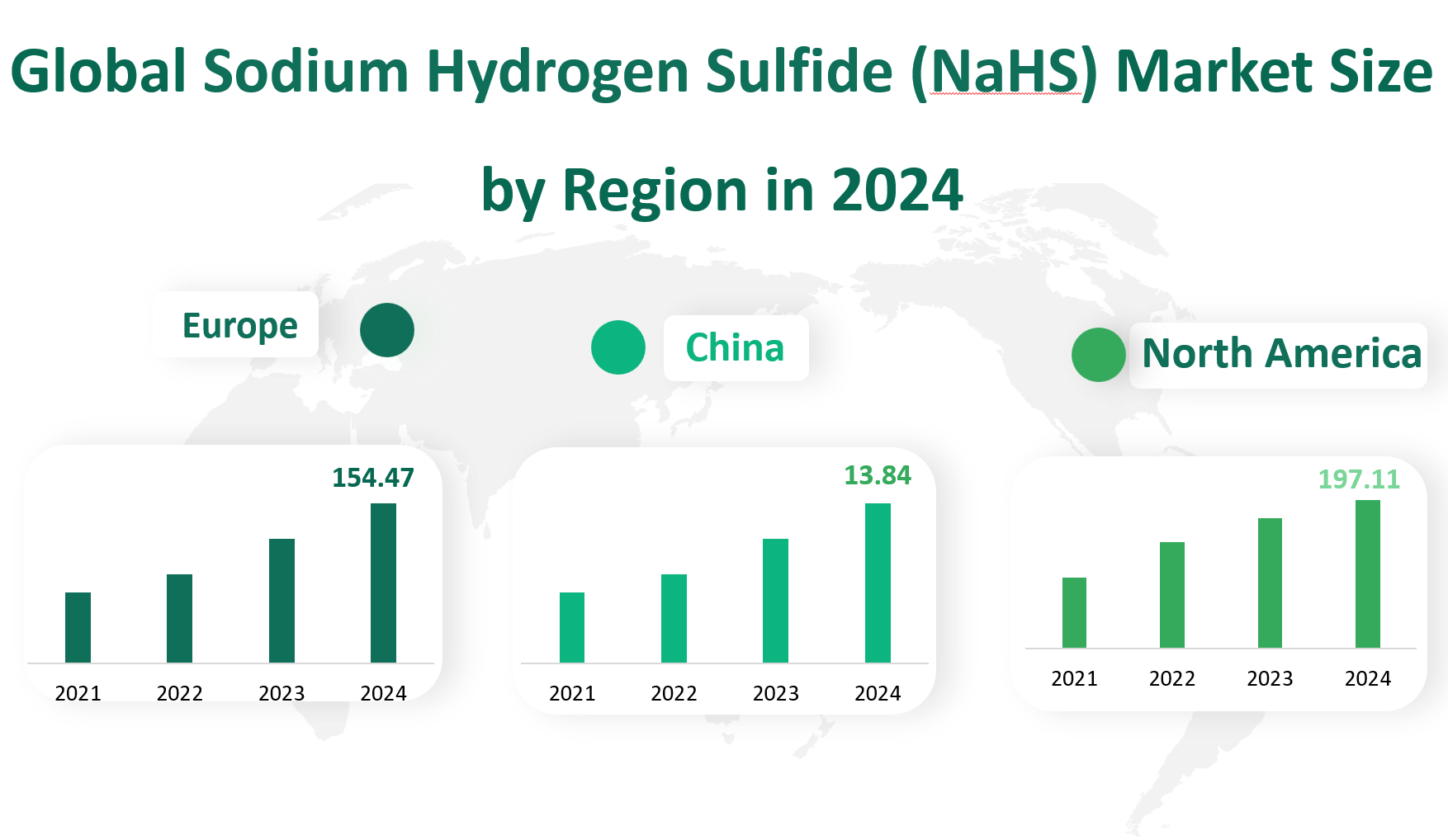1. Global Sodium Hydrogen Sulfide (NaHS) Market Insight Analysis
The global Sodium Hydrogen Sulfide (NaHS) market is projected to reach a value of 506.43 million USD in 2024, with a Compound Annual Growth Rate (CAGR) of 5.28% from 2024 to 2033.
Sodium Hydrogen Sulfide (NaHS) is a chemical compound with the formula NaHS. It is a semi-neutralized product formed from the reaction of hydrogen sulfide (H₂S) and sodium hydroxide (NaOH). NaHS is a versatile chemical with a wide range of industrial applications. It is commonly used in the paper and pulp industry as a cooking agent to break down lignin in wood, facilitating the production of pulp.
In the mining sector, NaHS acts as a flotation agent, particularly in the extraction of copper and other metals, by activating oxide mineral species. The chemical industry also relies on NaHS as a reaction material or intermediate, especially in the synthesis of sulfur dyes and other organic compounds. Additionally, NaHS is used in the leather industry as a depilatory agent to remove hair from hides and as a tanning agent. Its ability to dissolve in water and ethanol, coupled with its strong alkalinity, makes it an essential component in various industrial processes. However, due to its hygroscopic nature and potential to release hydrogen sulfide, a toxic gas, NaHS requires careful handling and storage.
Figure Global Sodium Hydrogen Sulfide (NaHS) Market Size (M USD) and CAGR (2024-2033)

2. Driving and Limiting Factors of Sodium Hydrogen Sulfide (NaHS) Market Growth
The growth of the Sodium Hydrogen Sulfide (NaHS) market is driven by several key factors. Firstly, the increasing demand from downstream industries such as paper and pulp, mining, and the chemical industry is a major driver. The expansion of these industries, particularly in emerging economies, has led to a higher consumption of NaHS.
Secondly, the compound’s versatility and effectiveness in various industrial applications make it an attractive choice for manufacturers. For instance, its use as a depilatory agent in leather production and as a flotation agent in mining ensures minimal waste and reduced environmental impact compared to other chemicals.
Additionally, the growing focus on pharmaceutical research and development has opened new avenues for NaHS, with studies exploring its potential in treating lipid metabolism disorders and kidney fibrosis. Economic development and technological progress have also played a significant role in driving the market. The global economy’s growth has increased the demand for daily necessities, leading to higher consumption of NaHS in various manufacturing processes. Technological advancements have improved production efficiency and reduced costs, making NaHS more accessible and affordable for industries.
Despite its growing demand, the Sodium Hydrogen Sulfide (NaHS) market faces several challenges. One of the primary limiting factors is the high manufacturing cost and operational complexity associated with its production. The industrial production of NaHS mainly relies on the caustic soda absorption method, which involves high costs, explosion risks, and low output. These factors can hinder the market’s expansion, especially for small and medium-sized enterprises.
Environmental regulations also pose a significant challenge. The production process of NaHS releases hydrogen sulfide, a toxic gas, which can harm the environment and human health. As a result, governments worldwide have imposed stricter environmental policies, requiring manufacturers to invest in advanced pollution control technologies. This has increased production costs and regulatory compliance burdens.
Additionally, the market faces competition from alternative sulfides and low-end products, which can capture market share due to their lower prices. The COVID-19 pandemic has also had a negative impact on the market, disrupting supply chains and reducing downstream demand, particularly in labor-intensive industries such as mining and leather production.
3. Technology Innovation and Corporate Mergers and Acquisitions in Sodium Hydrogen Sulfide (NaHS) Market
Technological innovation plays a crucial role in the Sodium Hydrogen Sulfide (NaHS) market. Companies are continuously investing in research and development to improve production processes, reduce costs, and enhance product quality. For instance, new methods are being explored to increase the yield and safety of NaHS production, such as optimizing the absorption process and developing alternative raw materials. These innovations not only improve the efficiency of NaHS production but also reduce its environmental impact.
Corporate mergers and acquisitions (M&A) are also shaping the market landscape. Major players in the industry are engaging in strategic partnerships and acquisitions to expand their market share and enhance their technological capabilities. For example, companies like Genesis Energy, Fenshi Chemical, and Nouryon have been actively involved in M&A activities to consolidate their positions and gain a competitive edge.
4. Global Sodium Hydrogen Sulfide (NaHS) Market Size by Type
Sodium Hydrogen Sulfide (NaHS) is available in two primary forms: solid and liquid.
Solid NaHS is a white hygroscopic crystal that turns yellow or orange when heated in dry air. It is highly soluble in water and ethanol, making it suitable for various industrial processes. Solid NaHS is commonly used in the production of dyes, leather processing, and as a depilatory agent in the tanning industry. Its strong alkalinity and ability to release hydrogen sulfide upon reaction with acids make it a valuable reagent in chemical synthesis.
In 2024, the market value of solid NaHS is projected to reach $389.53 million. Solid NaHS holds a significant market share due to its versatility and ease of handling in industrial settings.
Liquid NaHS is a colorless to light yellow solution, highly corrosive to metals and structures. It is used extensively in industries where rapid dissolution and reaction are required. Liquid NaHS is particularly useful in the mining industry for the extraction of metals and in the paper and pulp industry for its role in the Kraft pulping process. Its ability to precipitate heavy metals from ores makes it an essential component in metal recovery and wastewater treatment. The market value of liquid NaHS in 2024 is forecasted to be $116.90 million.
Table Global Sodium Hydrogen Sulfide (NaHS) Market Size by Type in 2024
5. Global Sodium Hydrogen Sulfide (NaHS) Market Size by Application
The chemical industry is a significant consumer of NaHS, utilizing it as a reaction material or intermediate in the production of various chemicals. NaHS is also used as an auxiliary agent in the manufacture of sulfur dyes. In 2024, the market value for NaHS in the chemical industry is projected to be $63.67 million, representing a substantial portion of the total market.
In the dyestuff industry, NaHS is used as an auxiliary for the synthesis of organic intermediates and the preparation of sulfur dyes. The market value for NaHS in this sector in 2024 is estimated at $39.43 million.
The paper and pulp industry is one of the largest consumers of NaHS, using it as a cooking agent in the Kraft pulping process. NaHS helps maintain sulfur levels and acts as a catalyst to increase the reaction rate, making it essential for efficient paper production. The market value for NaHS in this industry in 2024 is forecasted to be $252.05 million, reflecting its critical role in the industry.
In mining, NaHS is used as a flotation agent to activate oxide mineral species, aiding in the extraction of metals such as copper. The market value for NaHS in the mining industry in 2024 is expected to be $133.38 million.
The leather industry uses NaHS as a tanning agent or depilatory agent to remove hair from hides. The market value for NaHS in the leather industry in 2024 is projected to be $63.07 million.
Table Global Sodium Hydrogen Sulfide (NaHS) Market Size by Application in 2024
Application | Market Size (M USD) 2024 |
Chemical industry | 63.67 |
Dyestuff industry | 39.43 |
Paper and pulp | 252.05 |
Mining | 133.38 |
Leather industry | 63.07 |
Other | 33.46 |
6. Global Sodium Hydrogen Sulfide (NaHS) Market by Top Regions
North America remains the largest regional market for Sodium Hydrogen Sulfide (NaHS) in 2024, with an estimated market value of $197.11 million USD. The region’s robust industrial base, particularly in the chemical, paper and pulp, and mining industries, drives the high demand for NaHS.
Europe follows closely with a market value of $154.47 million USD in 2024. The region’s diverse industrial landscape, including significant contributions from the chemical, paper and pulp, and leather industries, ensures a steady demand for NaHS.
Japan, with a market value of $27.67 million USD in 2024, is another significant market for NaHS. The country’s advanced chemical industry and focus on high-quality products contribute to its market position.
The Middle East and Africa region is expected to have a market value of $25.31 million USD in 2024. The growth in this region is driven by the increasing demand from the chemical and mining industries, particularly in countries like Saudi Arabia, Iran, and South Africa.
India is another emerging market for NaHS, with a projected value of $28.20 million USD in 2024. The country’s growing economy and expanding industrial sector, particularly in the paper and pulp, mining, and chemical industries, are driving the demand for NaHS.
South America, with a market value of $41.44 million USD in 2024, is another important region for the NaHS market. The region’s rich mineral resources and growing industrial base, particularly in Brazil and Chile, ensure a steady demand for NaHS in mining and chemical applications.
Figure Global Sodium Hydrogen Sulfide (NaHS) Market Size by Region in 2024

7. Global Sodium Hydrogen Sulfide (NaHS) Market Analysis by Major Players
7.1 Genesis Energy
Introduction and Business Overview: Genesis Energy is a leading provider of midstream services in the crude oil and natural gas industry, with a strong presence in the United States. The company specializes in the production and distribution of Sodium Hydrogen Sulfide (NaHS) and other industrial chemicals. Its extensive network of plants and distribution centers ensures efficient supply chain management.
Products: Genesis Energy offers a range of high-purity NaHS products, including solid and liquid forms. These products are used in various industrial applications, such as mining, paper and pulp, and leather production.
7.2 Fenshi Chemical
Introduction and Business Overview: Fenshi Chemical is a prominent Chinese chemical enterprise known for its high-quality Sodium Hydrogen Sulfide (NaHS) products. Established in 2011, the company has rapidly grown to become a key player in the global NaHS market, with a strong focus on R&D, production, and sales.
Products: Fenshi Chemical produces both solid and liquid forms of NaHS, with a capacity of 68,000 tons of 70% flake NaHS and 80,000 tons of 60% flake sodium sulfide annually. Its products are widely used in copper ore dressing, printing and dyeing, leather, pharmaceuticals, and wastewater treatment.
7.3 Nouryon
Introduction and Business Overview: Nouryon, formerly known as AkzoNobel Specialty Chemicals, is a global leader in the production of specialty chemicals. The company operates in over 80 countries and is known for its innovative and sustainable production practices.
Products: Nouryon offers a range of high-quality NaHS products, primarily used in the chemical, paper and pulp, and mining industries. The company’s focus on environmental sustainability ensures that its products meet stringent regulatory standards.

